Archive for the ‘Featured Post’ Category
Gen Con 2014 Exclusive – ‘Star Wars: Armada’ Full Demo
Saturday, August 16th, 2014
Beginning today and concluding this Sunday is the annual Gen Con convention held in Indianapolis, originally started by Dungeons & Dragons creator Gary Gygax. Each year, publishers unveil new amazing new products and games; and this year is no different.
Team Covenant caught up with Star Wars: Armada lead designer James Kniffen of Fantasy Flight Games for a full demo and posted it to YouTube. Check out the demo in it’s entirety! Thanks Team Covenant!
Tags: Board Games, Demo, Fantasy Flight Games, Gen Con 2014, James Kniffen, Miniatures, Star Wars Armada, Team Covenant
Posted in Blog, Board Games, Featured Post | No Comments »
Rio Grande Games Announces Two New Board Games
Friday, August 15th, 2014
Rio Grande Games has announced two new games for third quarter release: Pressure Cooker and Rattlebones, according to hobby industry news website ICv2.com.
Releasing in September is the dice-building game Rattlebones, designed by Stephen Glenn (Balloon Cup, 1st and Goal). Players build customizable dice (rather than a customizable deck in a deck-building game), by removing and replacing sides on a standard 6-sided die, to build the best set of custom dice to score points.
The game is for 2-4 players, ages 14 and up, and plays in 30-60 minutes.
Releasing in August is a real-time set collecting game Pressure Cooker, designed by Kane Klenko (Mad City). Players take rolls as chefs at the hot new restaurant Tres Yummy on opening night, out to fill their orders the fastest and win the coveted roll of Head Chef. Over three rounds, players collect ingredient tiles to fulfill their orders accurately, thus earning points. Things move more quickly as the rounds progress. The highest point total at the end wins.
The game is for 2-4 players, ages 13 and up, and plays in 30-60 minutes.
Tags: Battlebones, Board Games, ICv2.com, New Release, Pressure Cooker, Rio Grand Games, TableTop
Posted in Blog, Board Games, Featured Post, Store Related | 1 Comment »
This week in Magic: A new deck and Mailbag Time!
Thursday, August 14th, 2014
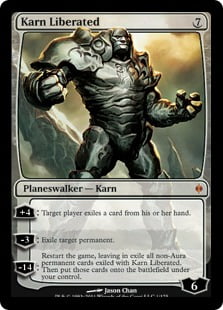
Welcome back to another “This week in Magic.” For those of you who have been following for a while, this will probably the last time I mention Mono Red Burn for a while. Reason being is that we’ve neared the end of the Modern season. There are a few more slightly major tournaments I can think of, but I won’t be playing Burn at them. The deck got it’s last bit of play this past weekend when I attended the TJ Collectibles Modern weekend.
There was a cash tournament on Saturday. I went 5-2 and was able to cash the event. Thanks to that result, I was able to play in the PTQ the following day. I didn’t do quite as well there. It was the first time I had played against Hatebears which also hates red…a lot. Mark of Asylum is just killer and once they dropped it, I found it almost impossible to win. It may have just been Phyrexian Unlife.
It’s really interesting to take a look at the deck I initially started with to what I ended up playing t the PTQ. The biggest difference is that I was able to get my hands on fetchlands. They made Searing Blaze (which was always the worst card in the deck without landfall) another reliable burn spell. They fuled another addition – Grim Lavamancer.
Now that the season has slowed down a bit, I’m going to try my hands at another deck. Here, take a look:
GR Tron
3x Wurmcoil Engine
2x Spellskite
1x Emrakul, the Aeons Torn
1x Sundering Titan
4x Karn Liberated
4x Oblivion Stone
4x Ancient Stirrings
4x Chromatic Star
4x Chromatic Sphere
4x Expedition Map
4x Sylvan Scrying
2x Relic of Progenitus
3x Pyroclasm
4x Urza’s Mine
4x Urza’s Tower
4x Urza’s Power Plant
1x Forest
1x Eye of Ugin
1x Ghost Quarter
1x Llanowar Wastes
4x Grove of the Burnwillows
If any of you are familiar with this list, this is the same list Cedric Phillips is known for playing. I’ve always been a big Tron fan and I think it’s set up pretty well right now. I know a lot of people are playing the Mono Blue version, but I like being able to have all of these tutor effects at my disposal.
I get that I’m completely vulnerable to any counterspells, but thanks to the absurd amount of mana I can potentially make, spells like Mana Leak and Spellpierce become moot. Remand isn’t even a problem since I can cast most things twice in one turn.
Still, I haven’t gotten a good chance to play this deck yet, but I’m hoping that will change soon. I am trying to make it to GP New Jersey which is happening in October. It’s Legacy fomat event, and I’ll be playing burn (which I’ll talk about another time). However, thanks to my performance at GP Boston, I’m actually close to accumulating enough Planeswalker Points for two byes at the event. That means I would need to squeeze in solid outings at a few events coming up – one of them being PTQ in New Hampshire the last day of the season.
It’s at these outings where I’ll try my luck with Tron. Hopefully I’ll have more to report on the deck then.
Mailbag Time!
Here on “This week in Magic” I’m going to try something new. Earlier this week I posted on all of the various Battleground Games & Hobbies social media accounts that I’d be holding a mailbag session for this week’s article. Let’s just say I’m happy I got a few submissions. So without further ado, let’s get to them.
This first question comes from Aaron. He writes:
Dear Simeon,
I know you have been doing well recently with Mono Red decks in both Standard and Modern, but what drew you to the color in the first place? Was it just purely for budget?
Good question Aaron. To tell you the truth, I have always considered myself more of a midrange player. There was a time where I thought I was a decent player, and had some success to back it up. That was during a time when I was playing “Esper Lark.” If you ask some of my other friends, they’d say I had some success with another deck called “Boat Brew.” This was a Boros aggro deck that flooded the board with Kithkins and Goblins and aimed at making them really big.
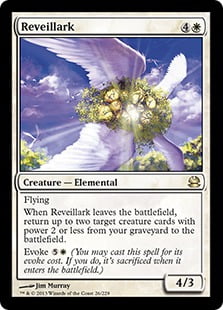
However, I’ve never really played a Mono Red deck. It was always too aggressive for my playstyle. I guess over the years it may have evolved into that. As far as Red being a budget deck, for Modern that is a big reason why I chose the deck. Fetchlands are very expensive right now thanks to the popularity of the Modern format. If Mono Red Burn didn’t have the success it had, I would not have had this much to write about.
As far as it being what I played in Standard, it’s something that was under the radar at the time. Thanks to that reason, playing the deck was more on the affordable side in Standard. At the same time, I should add that the deck is a lot of fun to play. I’m not sure I can say it’s the real deal right now. It’s only been out a few weeks. Although, it’s solid outting at the recent SCG Open shows that it could be here to stay. That is until it rotates out of Standard in October.
The next question comes from a player named Micah. He wrote:
Dear Simeon,
Why do you enjoy Modern so much?
That’s a fair question Micah. I like Modern because of it’s diversity. There are so many decks in the format that could win a tournament on a given day. This past weekend, there was a deck that play Generator Servant (a new creature from M15). The point of this deck was to get out a turn three Master of Cruelties. Yes, you heard me right. This is something you’d see in Standard, probably. However, here it was, doing well at a Modern PTQ. I don’t know how it finished, but it was sitting around the top tables for a bit.
Another example of diversity in Modern was a Mono Blue/ Turbo-Fog deck. Talk about annoying to play against, but I’m sure it was a lot of fun to play. This deck played cards like Gigadrowse to tap your opponent’s permanents, Exhaust to tap your opponent’s lands, and then take numerous turns with spells like Time Warp. How did it win? With Laboratory Maniac of course!

Our final question comes from someone who wishes to be called, “Puntmastr 4K.” He wrote:
Dear Simeon,
First of all, I’m a big fan of your writing. This is a two-part question. First, how does Scapeshift work? Secondly, assuming you’re using Scapeshift to get Valakut out, how exactly does the combo work?
Thanks for writing in “Puntmastr 4K.” That is an excellent question. So, Scapeshift is a sorcery speed spell from Morningtide that costs 2-colorless mana and 2-Green mana to cast. It allows the caster to sacrifice any number of lands from their battlefield, and then get that many lands from his or her library and put them into play. Don’t forget to shuffle your library afterwards!
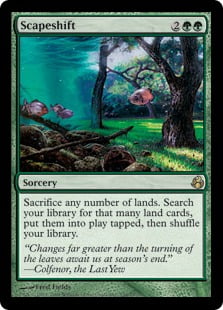
To answer the second part of your question, if you get Valakut, the Molten Pinnacle and enough Mountains, you can actually kill your opponent. So how does it work? Well, if your opponent is still at 20 life, you’ll need at least eight lands. The kind of lands you sacrifice doesn’t matter. The important thing is that you search your deck for two Valakuts and six Mountains. I’m not going to get too detailed with the timing and rules, but remember to have eight lands if your opponent is still around 20 life. With two Valakuts and six Mountains, this would deal 36 damage to your opponent.
Now of course, this can all change depending on how much your opponent has shocked or bolted themselves. In Modern, this is something that occurs all the time. In the event your opponent has hurt themselves because of fetchlands and shocklands, then you may only need seven lands to combo with. Here you would need a Valakut and six Mountains. This would deal 18 damage to your opponent.
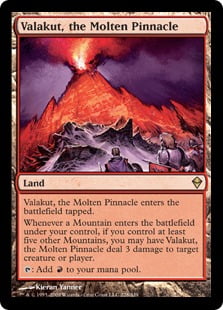
Well, that’s it for now. I hope you all enjoyed this week’s column, and more importantly, I hope you all enjoyed this Mailbag. If you want to participate in the next Mailbag, then send your questions to Sims@Battlegroundgames.com. I would love to answer your questions.
About the author
Simeon is now the Community Manager for Battleground Games & Hobbies. If you have any questions or inquiries, then you can reach him at Sims@battlegroundgames.com. He is also an avid gamer who loves to play board games and video games. He graduated college with a degree in Political Science, and now serves the public by writing about games. You can check that out here. Don’t forget to “like” him on Facebook as well. It’ll update you on all of his newest content. Best of all, you can follow Simeon on Twitter (@SimeonCortezano) for some real time hilarity. Thanks for reading!
Donate to the Extra-Life fundraiser!

Join the Battleground Games & Hobbies community forums!
Please don’t forget to check us out on Facebook and follow us on Twitter @battleground_gh!
Tags: GR Tron, Magic the Gathering, mailbag, MTG, scapeshift, Simeon Cortezano, valakut
Posted in Blog, Card Games, Featured Author, Featured Post, Magic: The Gathering, Popular Posts | 1 Comment »
Contents of ‘Magic the Gathering From the Vault: Annihilation’ Revealed!
Thursday, August 14th, 2014
Earlier this week, Wizards of the Coast R&D member Gavin Verhey revealed in an article the entire contents of the up-coming From the Vault: Annihilation collectors product. Furthermore, in the article, Mr. Verhey goes on to describe why each of these cards was selected in the design process. Let’s check out what the new 15 cards featuring the now familiar, unique From the Vault foiling style, but updated with the new card face and font. Don’t forget that a limited number of From the Vault’s will be coming soon to a Battleground Games & Hobbies near you!

Photo courtesy of Wizards of the Coast.
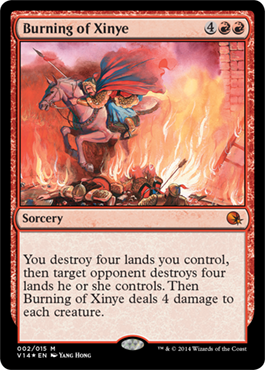
Photo courtesy of Wizards of the Coast.
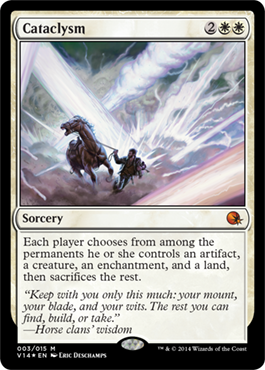
Photo courtesy of Wizards of the Coast.
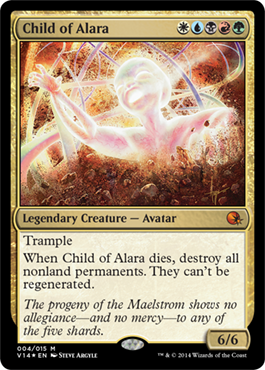
Photo courtesy of the Wizards of the Coast.
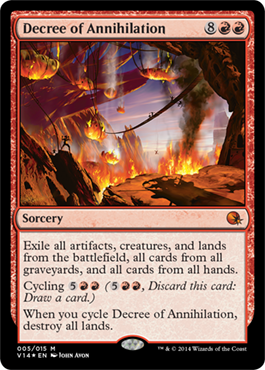
Photo courtesy of Wizards of the Coast.
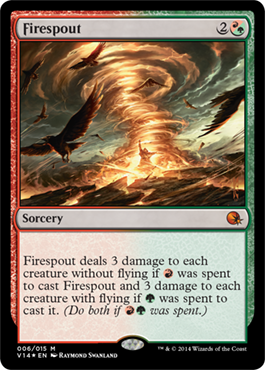
Photo courtesy of Wizards of the Coast.
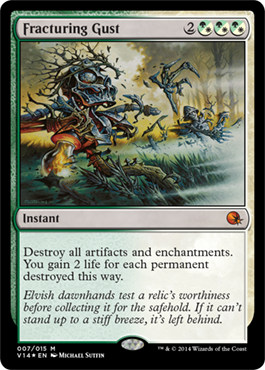
Photo courtesy of Wizards of the Coast.
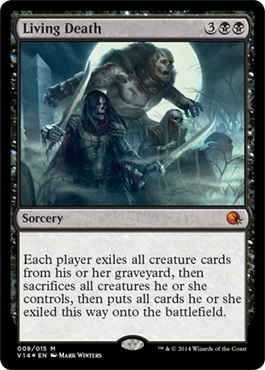
Photo courtesy of Wizards of the Coast.
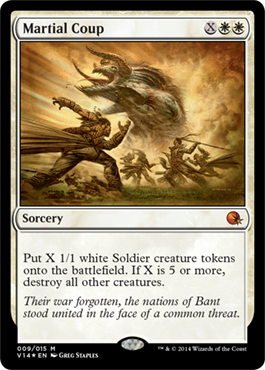
Photo courtesy of Wizards of the Coast.

Photo courtesy of Wizards of the Coast.
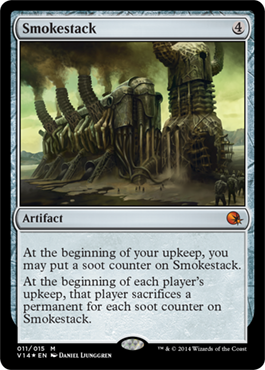
Photo courtesy of Wizards of the Coast.
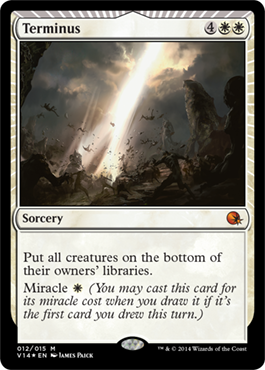
Photo courtesy of Wizards of the Coast.
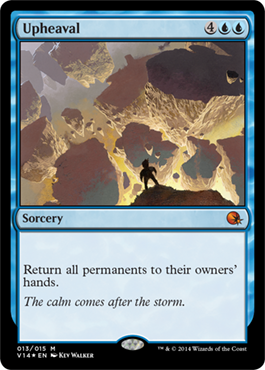
Photo courtesy of Wizards of the Coast.
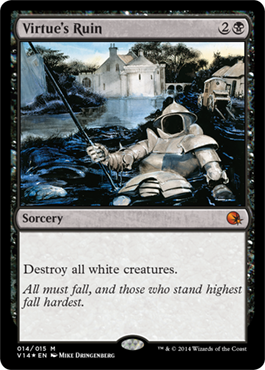
Photo courtesy of Wizards of the Coast.
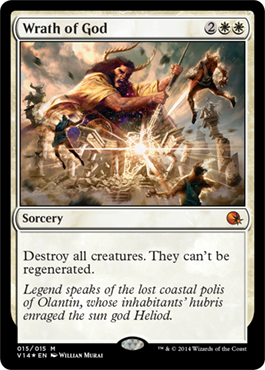
Photo courtesy of Wizards of the Coast.
And there you have it – From the Vault: Annihilation! So, what do you think? Are you happy with the 15 cards they selected? Are you looking forward to the latest installment in the From the Vault product series? Sound off in the comments below and tell us what you think!
Tags: From the Vault Annihilation, Magic the Gathering, MTG, New Product, Spoiler, Wizards of the Coast
Posted in Blog, Card Games, Featured Post, Magic: The Gathering, Store Related | 1 Comment »
Wizards of the Coast Announces ‘Magic the Gathering Duel Decks: Anthology’
Wednesday, August 13th, 2014
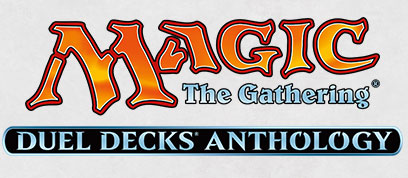
Never before have so many gathered in one place. These will be fights to remember.
These eight, ready-to-play, 60-card Magicdecks showcase our first four dueling match-ups. Rejoin the fray as the game’s most famous Planeswalkers go head to head. Relive the Divine clashing with the Demonic, and Elves confronting Goblins. Replay the original duels, or mix and match the combatants to create new battles across the Multiverse.
Duel Decks: Anthology contains all eight decks from the first four Duel Decks products:
- Duel Decks: Elves vs. Goblins
- Duel Decks: Jace vs. Chandra
- Duel Decks: Divine vs. Demonic
- Duel Decks: Garruk vs. Liliana
Official Three-Letter Code: DD3
Twitter Hashtag: #MTGAnthology
Languages Available: English
Release Date: December 5, 2014
MSRP: $99.99
Product Concept and Development:
- Duel Decks: Elves vs. Goblins—Devin Low & Noah Weil
- Duel Decks: Jace vs. Chandra—Erik Lauer & Ken Nagle
- Duel Decks: Divine vs. Demonic—Nate Heiss & Mike Turian
- Duel Decks: Garruk vs. Liliana—Gregory Marques & Erik Lauer
Please note: This set will not be released on Magic Online. Contents of this post borrowed and quoted from the original source, courtesy of Wizards of the Coast.
Tags: Anthology, Duel Decks, Magic the Gathering, MTG, New Product, Wizards of the Coast
Posted in Blog, Card Games, Featured Post, Magic: The Gathering | 1 Comment »
D&D Next Player’s Handbook: Initial Reaction by Sam Pearson
Tuesday, August 12th, 2014
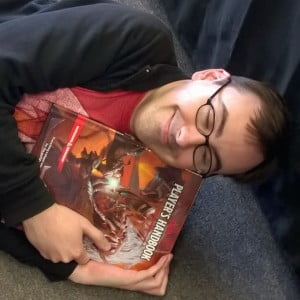
As many of you might know, I get excited about things. That’s kind of my job. But even I wasn’t prepared for what the 5th edition Player’s Handbook for Dungeons & Dragons did to me. Never before have I been such a roiling vortex of anticipation, wringing Twitter dry for each precious drop of information leading up to the release. You could have held a match to me, and it would have ignited. I was being held back from joy by the cruel, unrelenting slowness of time.
The book is out. I’m better now.
So let’s take a look at what patience and agony have bestowed upon us. Let’s see the PHB!
The Look
The first thing you’ll notice about the new Player’s Handbook is the art. You can’t escape it; it’s glorious. From the first glimpse of King Snurre’s rage on the front cover, to the paradigm-shattering sword-and-board fighter on page 148 (seriously, look it up), to page 191’s epic confrontation, the art draws you in and holds you. The style is unique, and every image evokes a whole universe of stories. Do yourself a favor and just page through once to look at the pretty pictures. Even if you’re a die-hard rules fan, it’s time well spent.
The Rules
Okay, this is the big one. I’ve heard the question a lot over the past year: “How do the new rules stack up?” The answer is: amazingly well. Gone are the restrictions of 4e, limiting players to a short list of powers and a gridded combat area. Gone is the arms race of 3.5, with players quickly outpacing any challenge the DM might be able to conjure. Derek calls 5e the best edition, and I agree. Let’s talk about why.
First, it’s easy. The core mechanic revolves around ability checks: roll a d20 and add a modifier from one of the six ability scores. That’s familiar ground for most D&D players, and takes five seconds to explain to anyone just starting with the game. There’s also a mechanic called advantage/disadvantage. Say you make an attack roll against an orc wearing a blindfold (who doesn’t happen to be a kung-fu master or something). You would make the roll with advantage: you roll two d20s and take the higher of the two to determine your result. It’s easy, effective, and intuitive. Conversely, say you’re attacking an orc while YOU wear the blindfold. Now you roll with disadvantage: roll two d20s and take the lower roll.
Show of hands. Who figured out what disadvantage was before I got to the end of that sentence? It’s such a simple concept, but anyone who sits down to play immediately grasps that advantage is something you want, and disadvantage is something you want to avoid like a huggy fire elemental. The mechanic also neatly addresses the problem of mountains of stacking bonuses. In 5th edition, you almost never have an ability score above 20. Without rare magic or twenty levels in barbarian, you simply can’t. This means that a check with a DC of 20 is always a difficult thing, even for high level characters. You never say “I smash through the iron door with my face. I don’t need to roll.” 5th edition has taken the sweet spot of 3.5, that fifth to tenth level range, and expanded that feeling to cover the entire play experience.
All right, on to the second big benefit of D&D Next: magic feels like magic. One of the big issues with 4e for a lot of players was that spells were just powers like any other. A fighter attacking everyone within two squares felt very similar to the wizard spraying fire in all directions; the mechanics were largely the same. But even 3.5, and by extension Pathfinder, made magic feel mundane. “Oh, look, another +1 sword. Shame I have a better one already. I guess we’ll sell it back in town.” I don’t know about you, but I feel like finding a magic item should never be boring. Magic should be wondrous. It should be a cut above the ordinary, a way to go beyond the normal framework of life. 5th edition brings back that wonder.
Spells slots are back, for a start. Powerful magic is a limited resource. But cantrip spells can be cast freely, all day, every day, so a wizard never becomes just some goofball in a pointy hat. And magic items are a big, big deal. They can’t be bought, for a start. You’re not going to find a store full of fabulous arcane equipment in every random village, and even large cities won’t have a magical emporium. If you want a +1 longsword, you go to a library, research King Arthur, puzzle out the final resting place of Excalibur, and go fight zombie knights until you can wrest your prize from the cold grasp of a long-dead king. And if you get tired of it, good luck selling it! Dropping that down in a general store and asking for coin would be like paying for your gum at a gas station using a gold brick. These items should be strange and wonderful, and the system is designed with that in mind. No longer is it assumed that a fifth level character has at least a +1 weapon and some magic armor; you can go all the way to level twenty without ever needing enchanted equipment. That just makes it all the better when you do find it.
The Mindset
Quite apart from the rules, the biggest change in D&D Next is one of approach. Wizards of the Coast has given us a Player’s Handbook that meets us halfway, or more than halfway; these are tools to tell your own stories. There’s a list of gods in an appendix for several campaign settings, including historical Earth (yes, you can be a cleric of Zeus). There are quotations, pictures, and references to the Forgotten Realms, Greyhawk, and Dragonlance throughout the book. Advice is given on how to make characters come to life, since roleplay is now as important a part of the system as combat, but the book always gives you options, never mandates. With this Player’s Handbook, Wizards of the Coast isn’t saying “Here’s our game, take it or leave it.” They have made it abundantly clear that this is our game, to play as we wish. 5th edition will never tell you that you’re having fun wrong.
As you read through the book, options abound. Strange races like dragonborn are there, but it’s explicitly mentioned that they may not fit all campaign settings. Feats exist (and are amazing), but are an optional component; you don’t have to have a twenty-level feat progression just to play the game, and it works fine without them. Each and every class has two or more different variants, from the many schools of magic for wizards to the different paladin oaths, providing extensive character customization. A party of five fighters can be as varied as any other, and still be quite effective.
And the options aren’t limited to the player’s side of the screen. D&D Next returns to an emphasis on DM rulings, not rules. The system gives DMs simple tools to describe and adjudicate any situation, then quietly lets you get on with it. One upshot of this method is compatibility: with appropriate monster conversions, you can run any adventure from any version of D&D or Pathfinder, converting the encounters on the fly. I’ve done it with the Tomb of Horrors and Expedition to the Barrier Peaks, running both straight out an AD&D 1st edition reprint. And with the Monster Manual coming out in September with its monster creation rules, and the Dungeon Master’s Guide in November with a whole host of options to hack the game for whatever you want to do, D&D Next will give us more freedom to play the game we want than we’ve ever had before.
Final Thoughts
I could go on. If we were standing around at the Plainville store, I probably would. I would talk about the beautifully simple spell preparation system. I’d tell you why fighters are better fighters than anyone else. I’d tell you why I want to play every single class in the whole Player’s Handbook, or how to make a dwarf wizard in armor, or how to know seven languages at level one. But all of that is just wasting time. The rules are out there, and as a wise man once said, you don’t have to take my word for it. I’ve found my favorite D&D, and maybe you will, too.
About the author
Sam is a passionate gamer who obviously loves his Dungeons and Dragons (see photo above). When he is not playing games he can be found working on his next novel. Did we mention he also works for Battleground Games & Hobbies? He does!
Join the Battleground Games & Hobbies community forums!
Please don’t forget to check us out on Facebook and follow us on Twitter @battleground_gh!
Tags: DND, dnd 5th edition, dnd next, Dungeons and Dragons, Player's Handbook, sam pearson
Posted in Blog, Dungeons & Dragons, Featured Author, Featured Post, Popular Posts, Role-Playing Games | 4 Comments »
Email Us
abington@battlegroundgames.com
norton@battlegroundgames.com
saugus@battlegroundgames.com
framingham@battlegroundgames.com
Archives
- October 2025
- September 2025
- June 2025
- May 2025
- March 2025
- November 2024
- October 2024
- September 2024
- February 2024
- October 2023
- June 2023
- January 2023
Categories
- Products
- Buylist
- Policies
- Contact Us


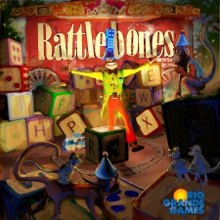
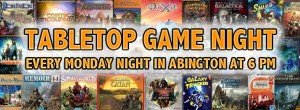




Social: